Hai Zhu
Query-LIFE: Query-aware Language Image Fusion Embedding for E-Commerce Relevance
Nov 26, 2023

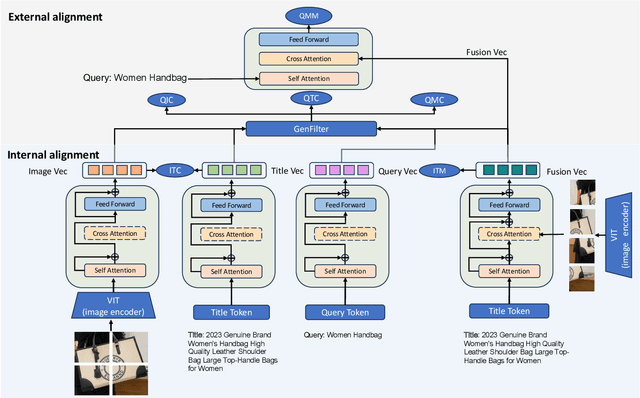

Abstract:Relevance module plays a fundamental role in e-commerce search as they are responsible for selecting relevant products from thousands of items based on user queries, thereby enhancing users experience and efficiency. The traditional approach models the relevance based product titles and queries, but the information in titles alone maybe insufficient to describe the products completely. A more general optimization approach is to further leverage product image information. In recent years, vision-language pre-training models have achieved impressive results in many scenarios, which leverage contrastive learning to map both textual and visual features into a joint embedding space. In e-commerce, a common practice is to fine-tune on the pre-trained model based on e-commerce data. However, the performance is sub-optimal because the vision-language pre-training models lack of alignment specifically designed for queries. In this paper, we propose a method called Query-LIFE (Query-aware Language Image Fusion Embedding) to address these challenges. Query-LIFE utilizes a query-based multimodal fusion to effectively incorporate the image and title based on the product types. Additionally, it employs query-aware modal alignment to enhance the accuracy of the comprehensive representation of products. Furthermore, we design GenFilt, which utilizes the generation capability of large models to filter out false negative samples and further improve the overall performance of the contrastive learning task in the model. Experiments have demonstrated that Query-LIFE outperforms existing baselines. We have conducted ablation studies and human evaluations to validate the effectiveness of each module within Query-LIFE. Moreover, Query-LIFE has been deployed on Miravia Search, resulting in improved both relevance and conversion efficiency.
Unwieldy Object Delivery with Nonholonomic Mobile Base: A Stable Pushing Approach
Sep 25, 2023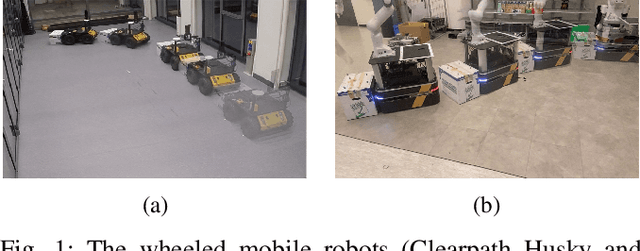
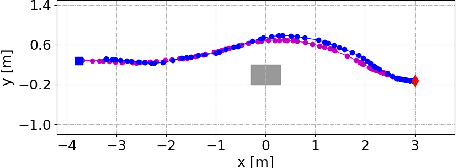

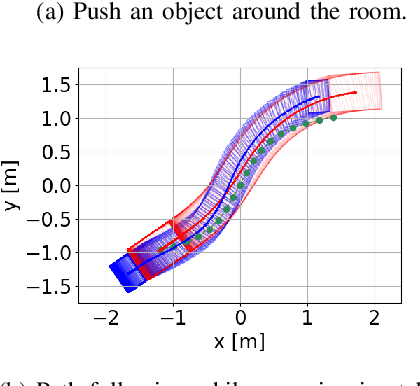
Abstract:This paper addresses the problem of pushing manipulation with nonholonomic mobile robots. Pushing is a fundamental skill that enables robots to move unwieldy objects that cannot be grasped. We propose a stable pushing method that maintains stiff contact between the robot and the object to avoid consuming repositioning actions. We prove that a line contact, rather than a single point contact, is necessary for nonholonomic robots to achieve stable pushing. We also show that the stable pushing constraint and the nonholonomic constraint of the robot can be simplified as a concise linear motion constraint. Then the pushing planning problem can be formulated as a constrained optimization problem using nonlinear model predictive control (NMPC). According to the experiments, our NMPC-based planner outperforms a reactive pushing strategy in terms of efficiency, reducing the robot's traveled distance by 23.8\% and time by 77.4\%. Furthermore, our method requires four fewer hyperparameters and decision variables than the Linear Time-Varying (LTV) MPC approach, making it easier to implement. Real-world experiments are carried out to validate the proposed method with two differential-drive robots, Husky and Boxer, under different friction conditions.
LimeAttack: Local Explainable Method for Textual Hard-Label Adversarial Attack
Aug 01, 2023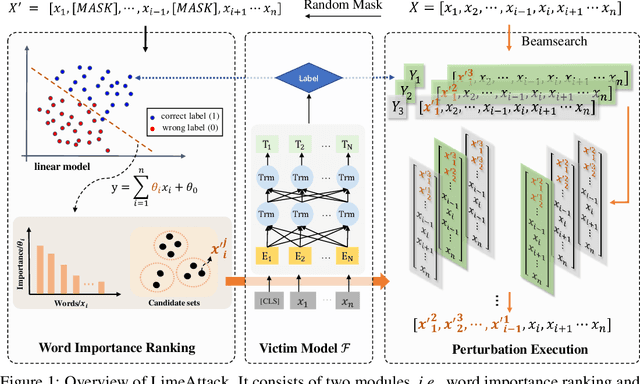
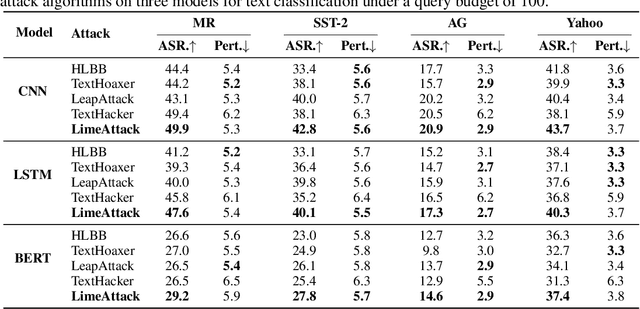
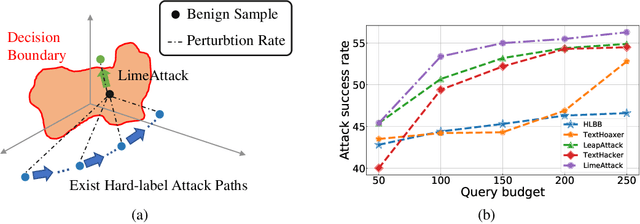

Abstract:Natural language processing models are vulnerable to adversarial examples. Previous textual adversarial attacks adopt gradients or confidence scores to calculate word importance ranking and generate adversarial examples. However, this information is unavailable in the real world. Therefore, we focus on a more realistic and challenging setting, named hard-label attack, in which the attacker can only query the model and obtain a discrete prediction label. Existing hard-label attack algorithms tend to initialize adversarial examples by random substitution and then utilize complex heuristic algorithms to optimize the adversarial perturbation. These methods require a lot of model queries and the attack success rate is restricted by adversary initialization. In this paper, we propose a novel hard-label attack algorithm named LimeAttack, which leverages a local explainable method to approximate word importance ranking, and then adopts beam search to find the optimal solution. Extensive experiments show that LimeAttack achieves the better attacking performance compared with existing hard-label attack under the same query budget. In addition, we evaluate the effectiveness of LimeAttack on large language models, and results indicate that adversarial examples remain a significant threat to large language models. The adversarial examples crafted by LimeAttack are highly transferable and effectively improve model robustness in adversarial training.
BeamAttack: Generating High-quality Textual Adversarial Examples through Beam Search and Mixed Semantic Spaces
Mar 09, 2023



Abstract:Natural language processing models based on neural networks are vulnerable to adversarial examples. These adversarial examples are imperceptible to human readers but can mislead models to make the wrong predictions. In a black-box setting, attacker can fool the model without knowing model's parameters and architecture. Previous works on word-level attacks widely use single semantic space and greedy search as a search strategy. However, these methods fail to balance the attack success rate, quality of adversarial examples and time consumption. In this paper, we propose BeamAttack, a textual attack algorithm that makes use of mixed semantic spaces and improved beam search to craft high-quality adversarial examples. Extensive experiments demonstrate that BeamAttack can improve attack success rate while saving numerous queries and time, e.g., improving at most 7\% attack success rate than greedy search when attacking the examples from MR dataset. Compared with heuristic search, BeamAttack can save at most 85\% model queries and achieve a competitive attack success rate. The adversarial examples crafted by BeamAttack are highly transferable and can effectively improve model's robustness during adversarial training. Code is available at https://github.com/zhuhai-ustc/beamattack/tree/master
Multi-robot Task Assignment for Aerial Tracking with Viewpoint Constraints
May 31, 2022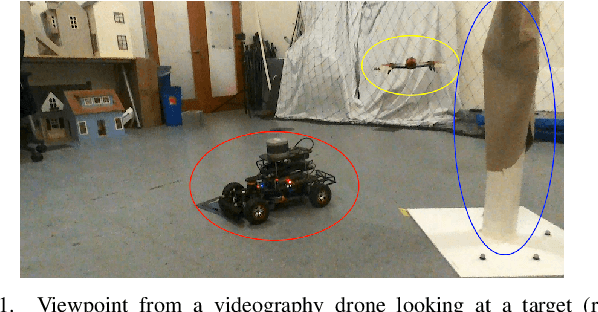
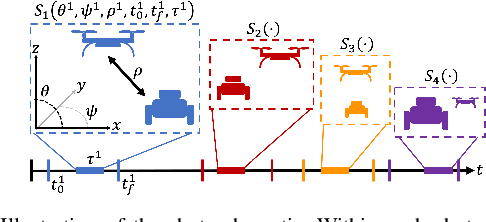
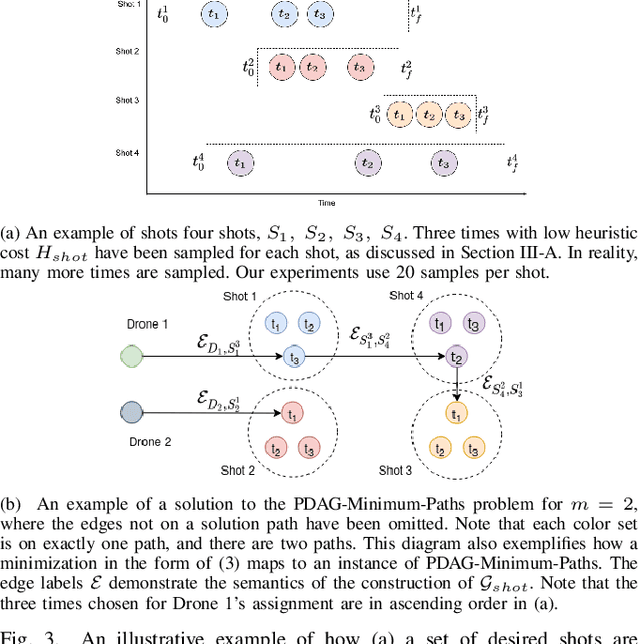
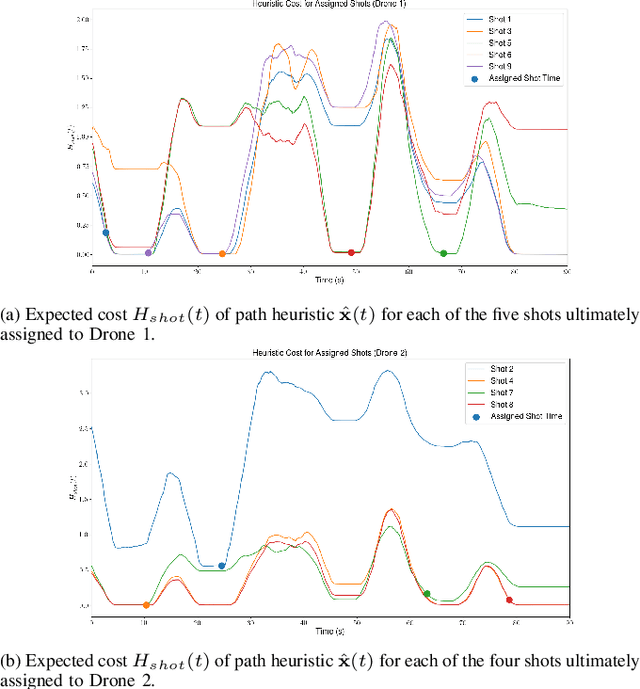
Abstract:We address the problem of assigning a team of drones to autonomously capture a set desired shots of a dynamic target in the presence of obstacles. We present a two-stage planning pipeline that generates offline an assignment of drone to shots and locally optimizes online the viewpoint. Given desired shot parameters, the high-level planner uses a visibility heuristic to predict good times for capturing each shot and uses an Integer Linear Program to compute drone assignments. An online Model Predictive Control algorithm uses the assignments as reference to capture the shots. The algorithm is validated in hardware with a pair of drones and a remote controlled car.
Improving Pedestrian Prediction Models with Self-Supervised Continual Learning
Feb 15, 2022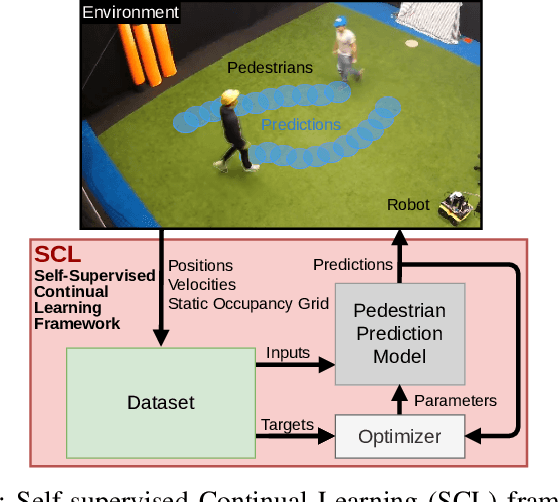
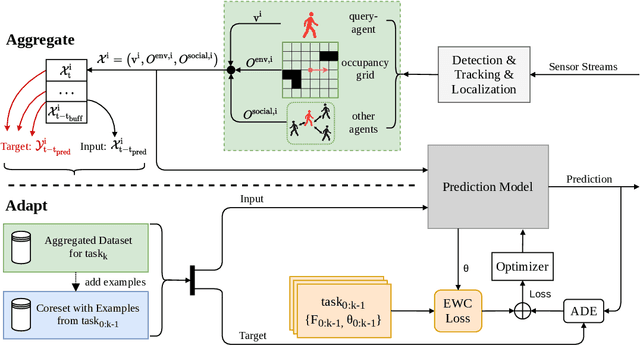
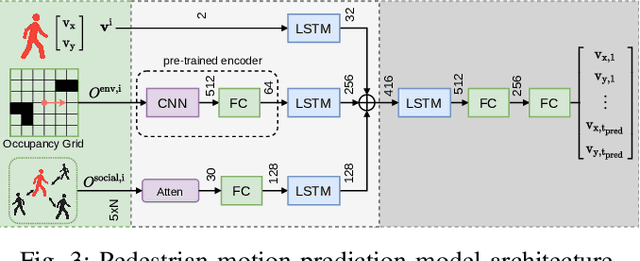
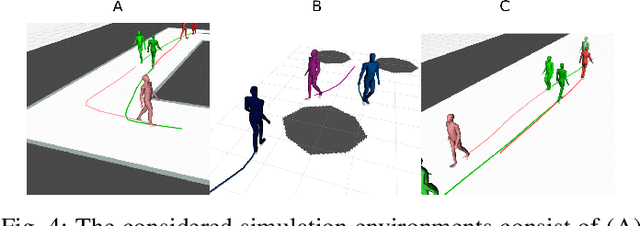
Abstract:Autonomous mobile robots require accurate human motion predictions to safely and efficiently navigate among pedestrians, whose behavior may adapt to environmental changes. This paper introduces a self-supervised continual learning framework to improve data-driven pedestrian prediction models online across various scenarios continuously. In particular, we exploit online streams of pedestrian data, commonly available from the robot's detection and tracking pipeline, to refine the prediction model and its performance in unseen scenarios. To avoid the forgetting of previously learned concepts, a problem known as catastrophic forgetting, our framework includes a regularization loss to penalize changes of model parameters that are important for previous scenarios and retrains on a set of previous examples to retain past knowledge. Experimental results on real and simulation data show that our approach can improve prediction performance in unseen scenarios while retaining knowledge from seen scenarios when compared to naively training the prediction model online.
Decentralized Probabilistic Multi-Robot Collision Avoidance Using Buffered Uncertainty-Aware Voronoi Cells
Jan 11, 2022
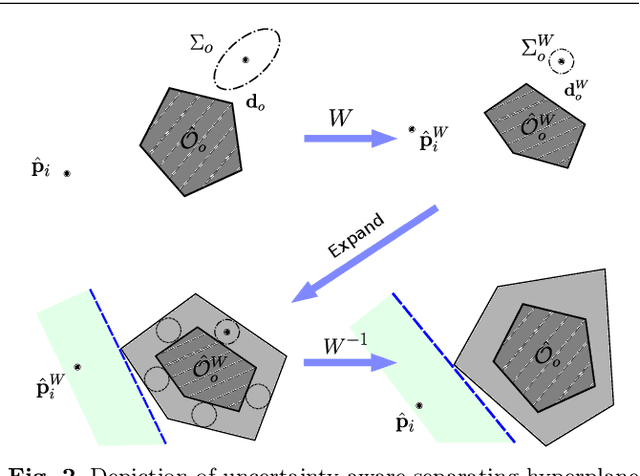
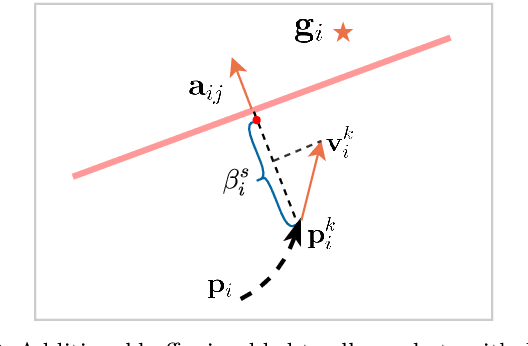

Abstract:In this paper, we present a decentralized and communication-free collision avoidance approach for multi-robot systems that accounts for both robot localization and sensing uncertainties. The approach relies on the computation of an uncertainty-aware safe region for each robot to navigate among other robots and static obstacles in the environment, under the assumption of Gaussian-distributed uncertainty. In particular, at each time step, we construct a chance-constrained buffered uncertainty-aware Voronoi cell (B-UAVC) for each robot given a specified collision probability threshold. Probabilistic collision avoidance is achieved by constraining the motion of each robot to be within its corresponding B-UAVC, i.e. the collision probability between the robots and obstacles remains below the specified threshold. The proposed approach is decentralized, communication-free, scalable with the number of robots and robust to robots' localization and sensing uncertainties. We applied the approach to single-integrator, double-integrator, differential-drive robots, and robots with general nonlinear dynamics. Extensive simulations and experiments with a team of ground vehicles, quadrotors, and heterogeneous robot teams are performed to analyze and validate the proposed approach.
Pitch Preservation In Singing Voice Synthesis
Oct 12, 2021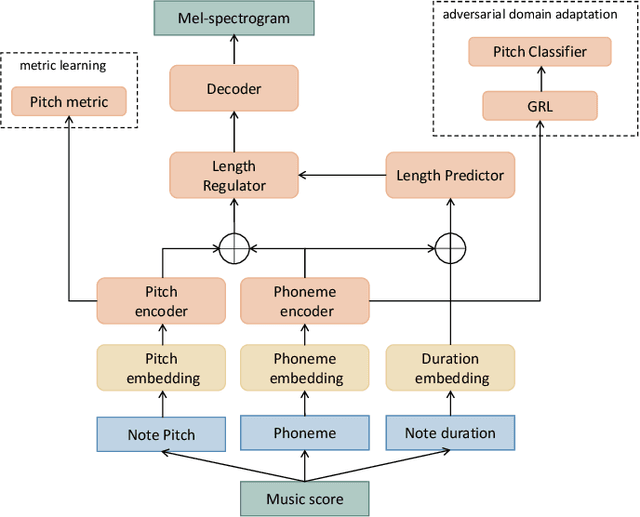
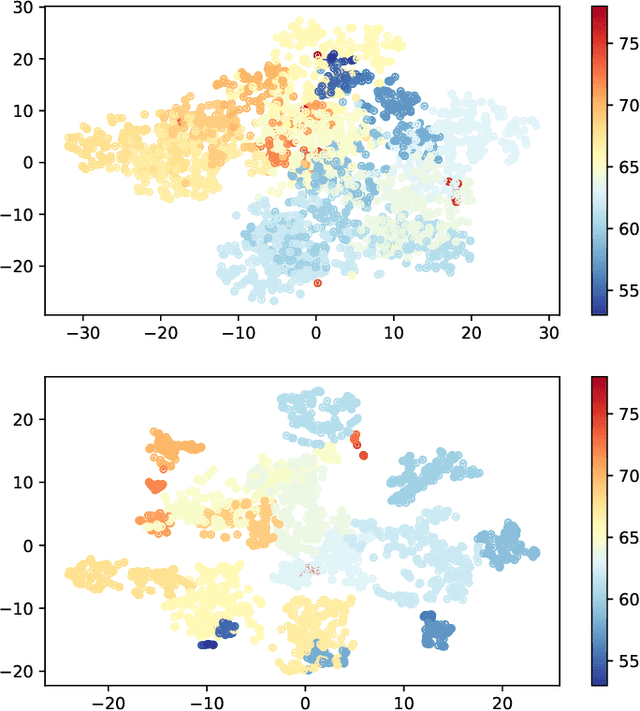
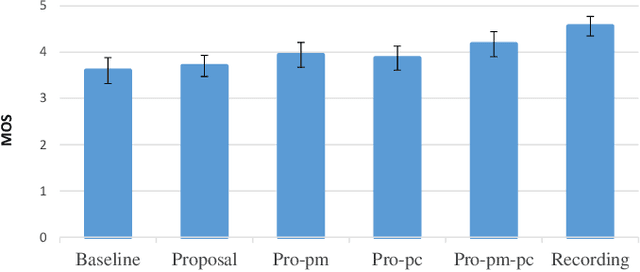

Abstract:Suffering from limited singing voice corpus, existing singing voice synthesis (SVS) methods that build encoder-decoder neural networks to directly generate spectrogram could lead to out-of-tune issues during the inference phase. To attenuate these issues, this paper presents a novel acoustic model with independent pitch encoder and phoneme encoder, which disentangles the phoneme and pitch information from music score to fully utilize the corpus. Specifically, according to equal temperament theory, the pitch encoder is constrained by a pitch metric loss that maps distances between adjacent input pitches into corresponding frequency multiples between the encoder outputs. For the phoneme encoder, based on the analysis that same phonemes corresponding to varying pitches can produce similar pronunciations, this encoder is followed by an adversarially trained pitch classifier to enforce the identical phonemes with different pitches mapping into the same phoneme feature space. By these means, the sparse phonemes and pitches in original input spaces can be transformed into more compact feature spaces respectively, where the same elements cluster closely and cooperate mutually to enhance synthesis quality. Then, the outputs of the two encoders are summed together to pass through the following decoder in the acoustic model. Experimental results indicate that the proposed approaches can characterize intrinsic structure between pitch inputs to obtain better pitch synthesis accuracy and achieve superior singing synthesis performance against the advanced baseline system.
Online Informative Path Planning for Active Information Gathering of a 3D Surface
Mar 17, 2021



Abstract:This paper presents an online informative path planning approach for active information gathering on three-dimensional surfaces using aerial robots. Most existing works on surface inspection focus on planning a path offline that can provide full coverage of the surface, which inherently assumes the surface information is uniformly distributed hence ignoring potential spatial correlations of the information field. In this paper, we utilize manifold Gaussian processes (mGPs) with geodesic kernel functions for mapping surface information fields and plan informative paths online in a receding horizon manner. Our approach actively plans information-gathering paths based on recent observations that respect dynamic constraints of the vehicle and a total flight time budget. We provide planning results for simulated temperature modeling for simple and complex 3D surface geometries (a cylinder and an aircraft model). We demonstrate that our informative planning method outperforms traditional approaches such as 3D coverage planning and random exploration, both in reconstruction error and information-theoretic metrics. We also show that by taking spatial correlations of the information field into planning using mGPs, the information gathering efficiency is significantly improved.
Learning Interaction-Aware Trajectory Predictions for Decentralized Multi-Robot Motion Planning in Dynamic Environments
Feb 23, 2021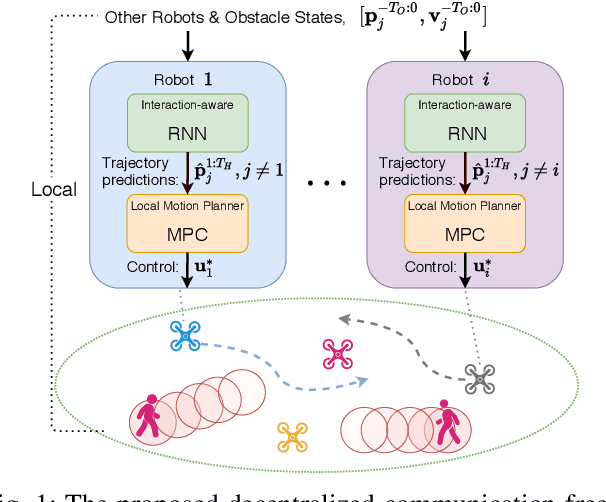
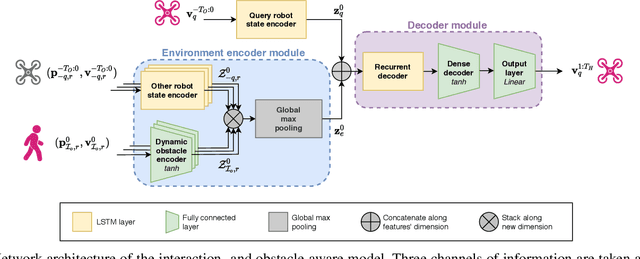

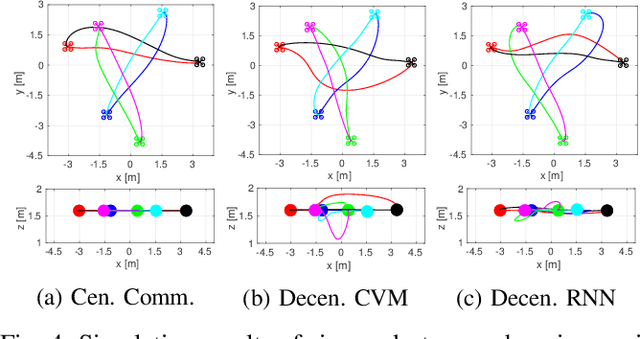
Abstract:This paper presents a data-driven decentralized trajectory optimization approach for multi-robot motion planning in dynamic environments. When navigating in a shared space, each robot needs accurate motion predictions of neighboring robots to achieve predictive collision avoidance. These motion predictions can be obtained among robots by sharing their future planned trajectories with each other via communication. However, such communication may not be available nor reliable in practice. In this paper, we introduce a novel trajectory prediction model based on recurrent neural networks (RNN) that can learn multi-robot motion behaviors from demonstrated trajectories generated using a centralized sequential planner. The learned model can run efficiently online for each robot and provide interaction-aware trajectory predictions of its neighbors based on observations of their history states. We then incorporate the trajectory prediction model into a decentralized model predictive control (MPC) framework for multi-robot collision avoidance. Simulation results show that our decentralized approach can achieve a comparable level of performance to a centralized planner while being communication-free and scalable to a large number of robots. We also validate our approach with a team of quadrotors in real-world experiments.
 Add to Chrome
Add to Chrome Add to Firefox
Add to Firefox Add to Edge
Add to Edge